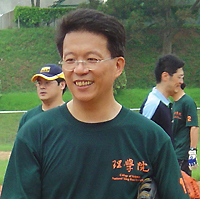| |
Education |
- 1992-1997 Ph.D. in Physics, National Taiwan University, R.O.C.
- 1990-1992 M.S. in Physics, National Cheng Kung University, R.O.C.
- 1981-1985 B.S. in Physics, National Tsing Hua University, R.O.C.
|
| |
Professional Experience |
Current position:
- 2001-present, Assistant Professor of physics Department, National Tsing Hua University, R.O.C.
Experience:
- 2000-2001 , Assistant Research Fellow of Physics Department, National Tsing Hua University, R.O.C.
- 1999-2000 , Postdoc Fellow of Institute of Physics , Academia Sinica, R.O.C.
- 1998-1999 , Postdoc Fellow of Chemistry Department, Graduate School of Science, The University of Tokyo, Japan.
- 1997-1998 , Postdoc Fellow of Institute of Physics , Academia Sinica, R.O.C.
|
| |
Research Fields |
-
- surface science
- scanning probe microscopy
|
| |
Research Interests and achievement |
Updated on September 3, 2006
My research interests focus on two branches of condensed matter physics. One is the interaction of adsorbed atoms or molecules on surfaces. The other one is the fabrication and characterization of nanostructures. The tools used in the investigations are variable-temperature STM and AFM. The very early stage of reaction of condensed matter occurs on the surface. Therefore, the interaction between surface and atoms or molecules is fundamental to the reaction followed. The beginning reaction of the foreign atom or molecule with the surface is adsorption. Intermediated by the surface, the interaction between adsorbed particles becomes more complex than that when they are in gaseous state. This interaction plays key role not only in the growth of thin films and the property of the adsorbate structures but also in the design of functional materials and sensors. On the other hand, nanostructures possess special properties due to their nanometer size, and thus attract intense attention in applications and fundamental researches. The nano vogue is mainly triggered after the inventions of STM and AFM due to their capability in fabrication, characterization, and observation of atomic structures. In presence, I am interested in the nanostructures on silicon wafers by using STM and AFM. Basically, the property of nanometer-size area can be altered physically, chemically, or mechanically by the probe of STM or AFM, and followed by physical or chemical processing, the nanostructure is made from the nanometer-size area.
|
| |
Selected Publications |
- [2006] R.-L. Lo, W.-C. Lee, and J. Kwo, AFM nano-lithography on hafnium oxide thin film grown on Si(100), Jpn. J. Appl. Phys. part I, 45, 2067-2069 (2006).
- [2006] R.-L. Lo, C.-M. Chang, I.-S. Hwang, and T. T. Tsong, Observation of single oxygen atoms decomposed from water molecules on Si(111)-7 × 7 surface, Phys. Rev. B 73, 075427 (2006).
- [2003] R.-L. Lo, I.-S. Hwang, and T. T. Tsong, Complete dissociation of water on hot silicon (111)-7×7 surface – direct observation of hopping oxygen atom, Surf. Sci. 530, L302 (2003).
- [2000] K. Fukui, R.-L. Lo, S. Otani, and Y. Iwasawa, Novel selective etching reaction of carbon atoms on molybdenum carbide by oxygen at room temperature visualized by ST M, Chem. Phys. Lett. 325, 275 (2000).
- [1999] R.-L. Lo, K. Fukui, S. Otani, and Y. Iwasawa, High resolution images of Mo2C(0001) -(Ö3´Ö3)R30o structure by STM, Surf. Sci. 440, L857 (1999).
- [1998] R.-L. Lo, I.-S. Hwang, M.-S. Ho, and T. T. Tsong, Diffusion of single hydrogen atoms on Si(111)-7×7 surfaces, Phys. Rev. Lett. 80, 5584 (1998).
- [1997] I.-S. Hwang, R.-L. Lo, and T. T. Tsong, Site hopping of single chemisorbed oxygen molecules on Si(111)-7×7 surfaces, Phys. Rev. Lett. 78, 4797 (1997).
|
|
-
-
A. Refereed Papers:
-
- T.T. Tsong, C.S. Chang, W.B. Su, H.N. Lin, T.C. Chang and R.-L. Lo, Chinese J. Phys. 32 (1994) 667 (R.O.C.), "High Field Effects Useful for Atomic Manipulations".
- T.T. Tsong, Rong-Li Lo, Tien-Chih Chang and Chonglin Chen, Surf. Rev. Lett. 1 (1994) 197, "Atomic Level Studies of the Dynamics and Dynamical Behavior of Solid Surfaces".
- Ing-Shouh Hwang, Rong-Li Lo and T.T. Tsong, Surf. Sci. 367 (1996) L47, "Continuous-time observation of pseudo-vacancy diffusion at Si(111)-7x7 surfaces".
- Ing-Shouh Hwang, Rong-Li Lo and T.T. Tsong, Phys. Rev. Lett. 78 (1997) 4797, "Site Hopping of Single Chemisorbed Oxygen Molecules on Si(111)-7x7 Surfaces".
- Ing-Shouh Hwang, Rong-Li Lo and T.T. Tsong, Surf. Sci. 399 (1998) 173, "Mechanisms and energetics of site hopping and chemical reactions of O2 molecules at Si(111)-7x7 surfaces".
- Rong-Li Lo, Ing-Shouh Hwang, Mon-Shu Ho and T.T. Tsong, Phys. Rev. Lett. 80 (1998) 5584, "Diffusion of Single Hydrogen Atoms on Si(111)-7x7 Surfaces".
- Ing-Shouh Hwang, Rong-Li Lo and T.T. Tsong, J. Vac. Sci. Technol. A 16 (1998) 2632, "Study of the dynamics of point defects at Si(111)-7x7 surfaces with scanning tunneling microscopy".
- Rong-Li Lo, Mon-Shu Ho, Ing-Shouh Hwang and T.T. Tsong, Phys. Rev. B 58 (1998) 9867, "Diffusion by bond hopping of hydrogen atoms on the Si(111)-7x7 surface".
- Rong-Li Lo, Ken-ichi Fukui and Yasuhiro Iwasawa, Jpn. J. Appl. Phys. 38 (1999) 3813, "C-termination reconstruction and C-chain structure on Mo2C(0001) surface studied by LEED and STM".
- Todd P.St. Clair, S.Ted Oyama, David F. Cox, Shigeki Otani, Yoshio Ishizawa, Rong-Li Lo, Ken-ichi Fukui and Yasuhiro Iwasawa, Surf. Sci. 426 (1999) 187, "Characterization of a-Mo2C(0001) surfaces".
- Rong-Li Lo, Ken-ichi Fukui, Shigeki Otani and Yasuhiro Iwasawa, Surf. Sci. 440 (1999) L857, "High resolution images of Mo2C(0001)-(O3xO3)R30o structure by STM".
- Ken-ichi Fukui, Rong-Li Lo, Shigeki Otani and Yasuhiro Iwasawa, Chem. Phys. Lett. 325 (2000) 275, " Novel Selective Etching Reaction of Carbon Atoms on Molybdenum Carbide by Oxygen at Room Temperature Visualized by Scanning Tunneling Microscopy".
- Tien T. Tsong, Chia-Seng Chang, Ing-Shouh Hwang, Tsu-Yi Fu, Wei-Bin Su, Mon-Shu Ho and Rong-Li Lo, J. Phys. Chem. Solids 62 (2001) 1689-1730, "Electron and Atom Dynamics at Solid Surfaces and Relation to Epitaxy".
|

